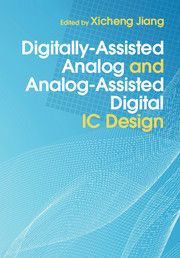Book contents
- Frontmatter
- Dedication
- Contents
- List of Contributors
- Preface
- 1 CMOS technology scaling and its implications
- 2 FinFETs: from devices to architectures
- 3 FDSOI technology and its implications for analog and digital design
- 4 Challenges and emerging trends of DSP-enabled frequency synthesizers
- 5 Digitally-assisted design of data converters
- 6 CMOS self-healing techniques for calibration and optimization of mm-wave transceivers
- 7 Analog-assisted digital design in mobile SoCs
- 8 Digitally-assisted RF design techniques
- 9 Digital controllers for switching power converters
- Appendix A
- Appendix B
- Index
- References
5 - Digitally-assisted design of data converters
Published online by Cambridge University Press: 05 August 2015
- Frontmatter
- Dedication
- Contents
- List of Contributors
- Preface
- 1 CMOS technology scaling and its implications
- 2 FinFETs: from devices to architectures
- 3 FDSOI technology and its implications for analog and digital design
- 4 Challenges and emerging trends of DSP-enabled frequency synthesizers
- 5 Digitally-assisted design of data converters
- 6 CMOS self-healing techniques for calibration and optimization of mm-wave transceivers
- 7 Analog-assisted digital design in mobile SoCs
- 8 Digitally-assisted RF design techniques
- 9 Digital controllers for switching power converters
- Appendix A
- Appendix B
- Index
- References
Summary
In this chapter, the recent trend of addressing a few challenging technical aspects of analog-to-digital converter (ADC) design using digital assistance is explored. In our viewpoint, digital assistance is a term evolved and directly descended from the conventional concept of digital calibration. The slight distinction between the two perhaps resides in the fact that the latest development of the technique is more focused on the so-called background treatment whereas earlier works often referred to a foreground case. Limited by the number of pages, this chapter will be dedicated to narrating the background digital techniques for enhancing raw analog performance metrics such as component matching, circuit linearity, and timing accuracy. As case studies, the converters discussed in this chapter include the pipeline and successive-approximation types. It is the goal to establish that digital assistance, when properly deployed, can help relax certain demanding aspects of an analog design, reduce the designers’ effort, and/or improve the power efficiency of the design.
We also point out that while it is true that a converter circuit is simplified in the conventional sense with digital assistance, one needs to recognize that the design complexity now is shifted to the system level – the design and verification of the digital algorithm that has to be integrated into the digital part of the converter or off-loaded to an external DSP or FPGA unit. In many cases, the background nature of the treatment requires billions or trillions of clock cycles for full verification of an algorithm, which can result in a significant bottleneck for the design process. In addition, the conception and design of the adaptive algorithms employed in digital assistance dictates knowledge and expertise outside the realm of conventional analog design. Thus, while the chips are becoming adaptive, the analog designers perhaps need to adapt along with the evolution of the technology and design arts.
Overview and historic remarks
5..1.1 Background vs. foreground calibration
In general, digital assistance is defined as the post-fabrication procedures of trimming, tuning, and/or reconfiguration of analog, mixed-signal (MS), and/or radio-frequency (RF) integrated circuits (IC) or post-processing of circuit outputs via digital means to obtain difficult- or expensive-to-obtain performance metrics with raw circuits. In general, it can be administered one time (e.g., during chip testing at either wafer or package level), occasionally (e.g., during circuit power-up or idle times), or in situ during the normal operation of the circuits.
- Type
- Chapter
- Information
- Digitally-Assisted Analog and Analog-Assisted Digital IC Design , pp. 135 - 173Publisher: Cambridge University PressPrint publication year: 2015

